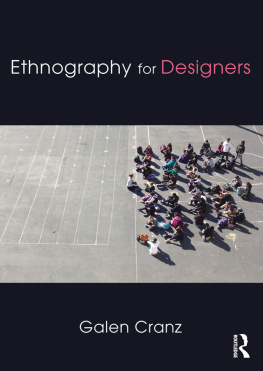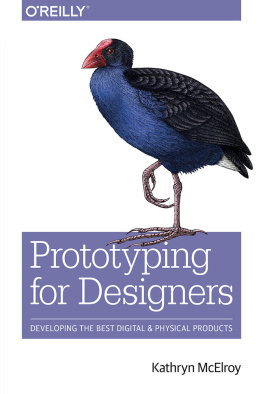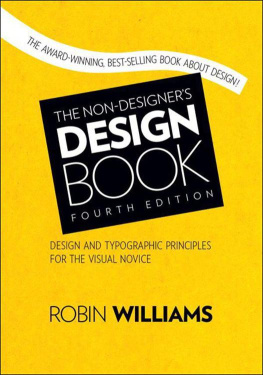Ethnography for Designers
Ethnography for Designers teaches architects and designers how to listen actively to the knowledge people have about their own culture. This approach gives structure to values and qualities. It does this by noting the terms and underlying structure of thought people use to describe aspects of their culture. By responding to underlying cognitive patterns, the architect can both respond to the user and interpret creatively. Thus, ethno-semantic methods can help designers enhance their professional responsibility to users and, at the same time, feel fulfilled creatively. This book is a practical guide for those teaching social factors and social research methods to designers and for those using these methods in practice.
Galen Cranz is Professor of Architecture at the University of California at Berkeley, a Ph.D. sociologist from the University of Chicago, and a certified teacher of the Alexander Technique. She teaches social and cultural approaches to architecture and urban design. Emphasizing ethnography as a research method, she brings users as well as creators perspectives to our understanding of built environments.
Cranz draws upon three decades of teaching semantic ethnography in this thoughtful guide to doing research for design. The ethnographic approach is uniquely suited to sensitive and nuanced study of spaces of micro-cultures. Designers will find it an effective tool in envisioning places that are supportive of local cultures.
Amita Sinha, Professor of Landscape Architecture, University of Illinois at Urbana Champaign, USA
The outcome of design activity typically implies the involvement of an audience. This much-needed text arms the designer with the cultural awareness and specific skills needed to approach projects in a refreshingly unbiased way. Noted sociologist Professor Galen Cranz who, for many years, has been deeply engaged with the education of designers, clarifies the ethnographic process and particularizes it for design. Ethnography for Designers provides designers with what they need to know about their audience and users as they inhabit the various research phases of any project.
Leslie Becker, Ph.D. Professor, Graphic Design and Visual Studies, California College of the Arts, San Francisco, California, USA
In Ethnography for Designers architects and architecture students will find an invaluable guide to conducting research projects that reveal culturally significant aspects of the built environment and that generate thoughtful design proposals. With an abundance of clear directives and excellent exemplars, Professor Cranz demonstrates how architects can be researchers and designers. As many become increasingly entranced with collecting large amounts of data, nearly mechanically with digital tools, the careful attention Cranz pays to listening and learning, to analyzing and imagining, is particularly welcome.
Karen A. Franck, Professor, New Jersey Institute of Technology and co-author of Design Through Dialogue and Architecture from the Inside Out
Ethnography for Designers is a tour de force away from common notions of science focused on deterministic hypothesis testing. Discovery science, so important to physical and biological sciences, is a welcome paradigm shift in the social sciences. Ethno-semantic methods empower creative architects to acquire cultural knowledge inspiring innovative new building forms to enhance their professional responsibility to users. This important book also thoughtfully acknowledges limitations of verbal interviews in accessing environmental meaning, suggesting a follow-up volume addressing the visual.
Eleftherios Pavlides Ph.D., AIA, Professor of Architecture, School of Architecture, Art and Historic Preservation, Roger Williams University, USA
Ethnography for Designers
Galen Cranz
First published 2016
by Routledge
2 Park Square, Milton Park, Abingdon, Oxon OX14 4RN
and by Routledge
711 Third Avenue, New York, NY 10017
Routledge is an imprint of the Taylor & Francis Group, an informa business
2016 Galen Cranz
The right of Galen Cranz to be identified as author of this work has been asserted by her in accordance with sections 77 and 78 of the Copyright, Designs and Patents Act 1988.
All rights reserved. No part of this book may be reprinted or reproduced or utilised in any form or by any electronic, mechanical, or other means, now known or hereafter invented, including photocopying and recording, or in any information storage or retrieval system, without permission in writing from the publishers.
Trademark notice : Product or corporate names may be trademarks or registered trademarks, and are used only for identification and explanation without intent to infringe.
British Library Cataloguing-in-Publication Data
A catalogue record for this book is available from the British Library
Library of Congress Cataloging-in-Publication Data
Cranz, Galen, author.
Ethnography for designers / Galen Cranz.
pages cm
Includes bibliographical references and index.
ISBN 978-1-138-12108-9 (hb: alk. paper) -- ISBN 978-1-138-12109-6 (pb: alk. paper) ISBN 978-1-315-65126-2 (ebook) 1. Architects and community. 2. Architectural practice--Social aspects. 3. Applied anthropology. I. Title.
NA2543.S6C74 2016
720'.47--dc23
2015035195
ISBN: 978-1-138-12108-9 (hbk)
ISBN: 978-1-138-12109-6 (pbk)
ISBN: 978-1-315-65126-2 (ebk)
Typeset in Sabon by
Servis Filmsetting Ltd, Stockport, Cheshire
Contents
Ethnography for Designers helps architecture and design students learn how to listen actively and deeply to clients and users. Listening is profound and simple, useful to professionals and to all of us as people. This book provides practical tips for applying ethnography to architectural and other types of design.
I have been introduced to design thinking primarily through architecture, but this book is addressed to all designers of the material world. Architects have been thinking about the social meaning of their work for centuries. The Roman architect and theorist Vitruvius named three facets of architecture: firmness, commodity, and delight. He thought that a building should stand up, accommodate peoples activities, and be artistic. All design could be said to be the union of these three concerns: social purpose, structure, and aesthetics. An architect is not just a structural engineer, nor only a sociologist, nor solely an artist. Over time, however, the artistic function of architecture has come to have most of the emotional hold on both faculty and students in architecture schools. In the 1970s some architects were concerned that they had erred on the artistic side of the equation, and so they recruited social scientists to architecture faculties to rebalance a previous weight on structure and appearance.
One of the reasons that architects decided to bring sociologists and psychologists into their field was that the architecture profession had been embarrassed by social failures of some notable buildings, the most infamous having been the prize-winning public housing complex, Pruitt Igoe in St. Louis, Missouri. Together the planners and architects of those high-rises imagined that they could support neighborliness if they created an elevator system that stopped only on every other floor, thereby encouraging people on different floors to meet one another. Instead, this building became notorious for crime in the stairwells. For several reasons like this, the building was deemed unsuitable for single-parent families and eventually was blown up in 1972.














